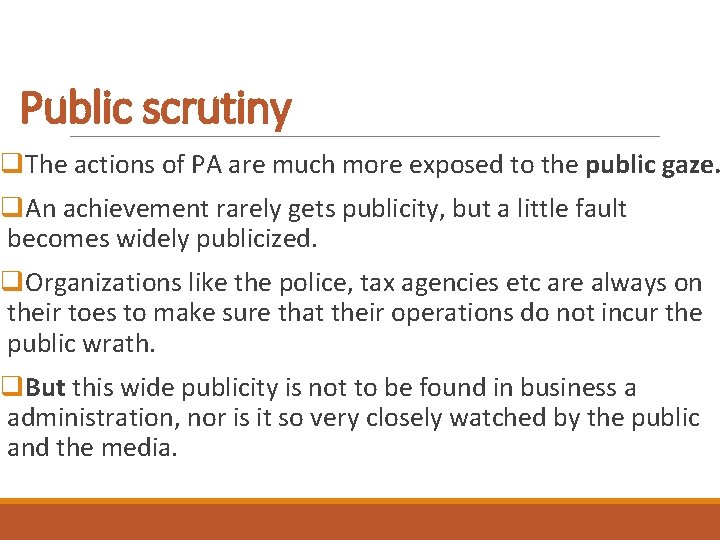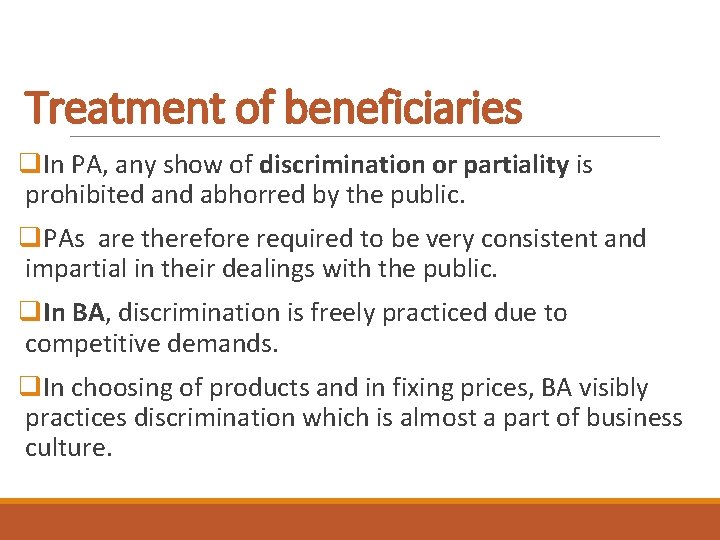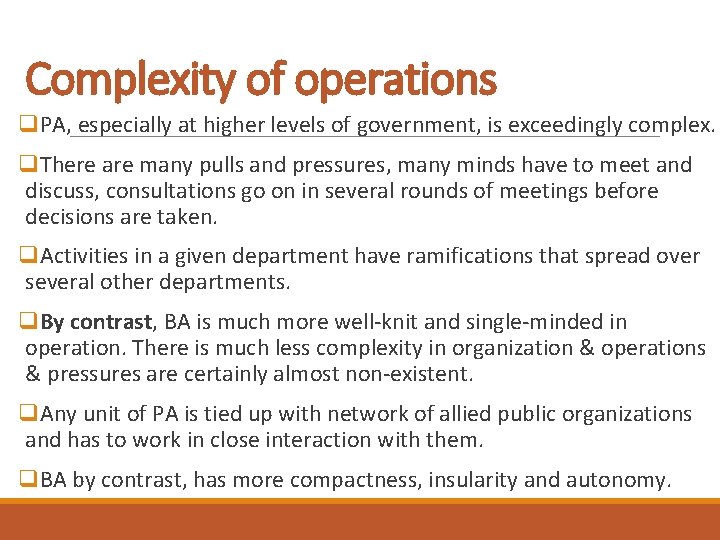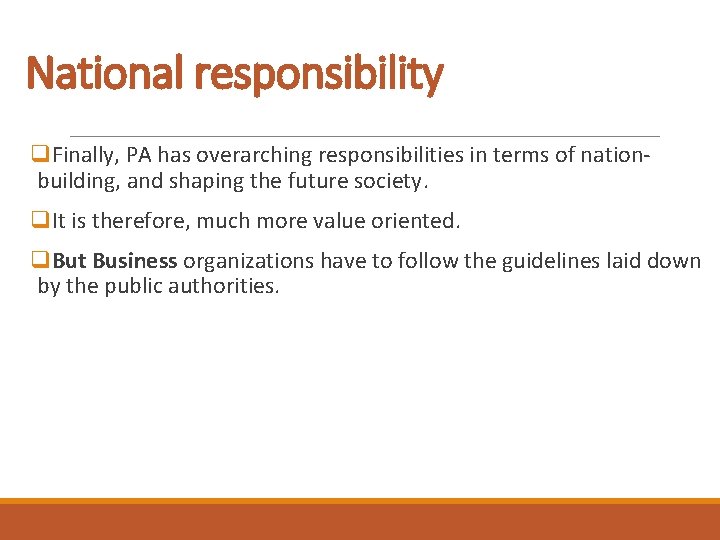PUBLIC ADMINISTRATION q THE MEANING NATURE SCOPE OF

PUBLIC ADMINISTRATION q THE MEANING, NATURE & SCOPE OF PA q STRUCTURE OF GHANAIAN PA q COMPARING BUSINESS & PUBLIC ADMIN

Definition, nature and scope of PA q. Public Administration covers a very wide range of issues which makes it difficult to find a single worldwide accepted, definition for it. q. Dwight Waldo “no single, and authoritative definition of public administration is possible”. q. This is due to its eclectic nature – q. It has a broad scope and so debatable q. The definitions are often skewed depending on who does it – sociologist, economist, psychologist, and political scientist. q. To properly understand it therefore implies that one has to view it from different dimensions.

What is public? q. Something that is open q. Communal q. Unrestricted q. Easy access q. Berkley and Rouse in their book “The Craft of Public Administration” see public simply as the citizens of a given area i. e. , the people of a town or country. q. Public in general terms refer to something that belongs to the people as a whole.

What is administration? q. Administer originated from Latin word – ministiare meaning to serve q. Administer means to look after or manage the affairs of people q‘The organization and direction of human and material resources to achieved desire ends. ’ (Pfifner and Prethus – Public Administration) q‘Consist of systematic ordering of affair and the calculated use of resources aimed at making those things happen which we want to happen and simultaneously preventing developments that fail to square with our intentions. ’ (Fritz Morstein Marx 1946)

Cont. q. There is technology of social relationship without which technology of physical sciences could not function. And that is administration. q. The technology of ensuring harmonious combination of men and material resources to produce expected results is what we call administration. q It is therefore a collective activity towards the realization of defined goal. q A collective activity involving rational organization & mgmt of men & material. q. This may occur at all levels ranging from social clubs, individual businesses levels, corporations, institutions like the university, the state etc. q. Administration may therefore be private – club, companies, or public – state, regional, local government levels

Cont. q. Administration generally refers to the day-today management of activities to achieve a goal. q. Administration is to care for or to look after people, to manage affairs (E. N. Gladden). q. Herbert Simeon et al, define administration in an opening sentence as ‘When two men cooperate to roll a stone that neither could have moved alone, the rudiments of administration have appeared’. q. Thus administration was born when two people decided to take an action from one place to another.

Cont. q. This means that for any two people to take action for a fruitful aim, the following ingredient of administration must be in place. q -People - must be present and agree to take the action q -Action - A step must be taken regarding what to do. q -Interaction - The two must agree to relate and combine their efforts to take action. q. Administration also refers to the activities of group of persons cooperating among goals.

Contd. q. The administrator is therefore concerned with a cooperative activity. They interact with others to accomplish tasks. q. This is not to say that every activity that involves the interaction of people is administration. q. Administration in itself is a process which involves human beings jointly engaged in working toward common goals. q. Administration therefore takes place in human society. q. When ever an activity involves more than two people it becomes complex. q To be an expert in administration one should know the principles. q. This principles work in any form of administration.

What is Public Administration? q. It is the action part of government, the means by which the purposes and goals of governments are achieved. q. May be described as representing the executive arm of government q. It is centrally concerned with the organization of government policies and programs as well as the behavior of officials (usually non-elected) formally responsible for their conduct q. It houses the implementation of government policy and an academic discipline that studies this implementation and that prepares civil servants for this work q. As a "field of inquiry with a diverse scope" its "fundamental goal. . . is to advance management and policies so that government can function. “ q"the management of public programs” qthe "translation of politics into the reality that citizens see every day"

Selected definitions of PA q. Grover (1998: 10) stated that public administration is the process by which resources are marshaled and then used to cope with the problems facing a political community; q. David (1986: 6) sees it as “the use of managerial, political and legal theories and processes to fulfill legislative, executive and judicial governmental mandates for the provision of regulatory and service functions for the society as a whole or for some segments of it”. q. Leonard (1955: 3), broadly defines it as “consisting of all those operations having for their purpose the fulfillment or enforcement of public policy”.

Cont. q"Public Administration is detailed and systematic execution of public law. Every particular application of law is an act of administration" - L. D. White. q. Public Administration is "the art and science of management applied to the affairs of the State" - D. Waldo. q"By Public Administration is meant in common usage the activities of the executive branches of the National, State and Local Governments'' - H. Simon. q. It is a means by which the policy decisions made by the political decision makers are carried out. q. It is the action part of the government, the means by which the purposes and goals of the government are realized.

Cont. q. Public Administration is decision making, planning the work to be done, formulating objectives and goals, working with the legislature and citizen organizations to gain public support and funds for governmental programmes, establishing and revising organization, directing and supervising employees, providing leadership, communicating and receiving communications, determining work methods and procedures, appraising performance, exercising controls and other functions performed by government executives and supervisors.

Cont. q. Public administration may be defined as the action part of government the means by which the purposes and the goals of government are realized. q. Inferring from the above definition several others, Ghana's public administration system is therefore the part of government through which the government of Ghana actualizes whatever vision, goals, objectives it sets for itself. q. Public administration is therefore the management of the scarce resources, that is, financial, human and material of a community by elected and unelected public officials to benefit the community in question. q. Public administration is an art, which strategically combines these resources to maximize their utilization in the interest of the citizens within a governed jurisdiction.

Characteristics of PA q. The 'Public' aspect of Public Administration gives the discipline a special character. It may be viewed to formally mean government. So q. Public Administration is government administration, the focus being specifically on public bureaucracy. q. It is a cooperative group effort in a public setting. q. It covers all three branches –legislative, executive and judicial - and their interrelationships. q. It has an important role in the formulation of public policy, and is thus a part of the political process. q. It is different in significant ways from private administration. q. It is closely associated with numerous private groups and individuals in providing services to the community.

Domain and scope of PA q. Public Administration is the complex of governmental activities that are undertaken in public interest at different levels such as the central, regional/state /provincial and local. q. The discipline of PA aims at a systematic study of these activities. q. It is widely acknowledged that the scope of the discipline of PA has to be wide enough to respond to the complex social realities of today.

PA has 5 major concerns namely: q. Promoting Publicness q. Policy Sensitivity q. Implementation Capability q. Shared understanding of social reality q. Administration as a learning experience

Promoting Publicness q. In a democratic society, PA has to be explicitly 'public' in terms of democratic values, power-sharing and openness. q. This calls for a new climate in the bureaucracy. q. PA in practice has to absorb the principles of democracy as an overarching form of the government.

Policy Sensitivity q. As governments are called upon to play increasingly active roles in times of rapid changes and social crisis, innovative and timely policy formulation becomes a prime necessity in the government. q. This would necessitate a new preparedness within the administrative set-up that had hardly any precedence in the past.

Implementation Capability q. Effective policy implementation is a test kit for the coping capacity of the governments in today's complex situations. q. Goals have to be clearly set; planning, programming and projections have to be followed step by step; and project management in all its ramifications has to have top priority in government. q. The strength of administration and the legitimacy of the government itself depend more and more on the administration's capacity to deliver the goods in time and in response to the demands of the citizens.

Shared understanding of social reality q. The capacity to cope with social and administrative complexity can be enhanced by a deliberate policy of organizational openness. q. The underlying assumption here is that the administration needs to understand the diverse interests and influences. q. In today's complex administrative world, construction of administrative reality has to be based on the shared understanding of its actors such as the top and middle managers, the employees, and the citizens. q. The centralized bureaucracy does not fit in with the contemporaneous socio-administrative reality.

Administration as a learning experience q. Shifting social reality and complex environmental conditions impose certain rigors on PA today. q. Rusted 'principles' of the past or the administrative recipes of bureaucratic routine are no longer appropriate tools for analysis and problem solving. q. Public Administration in modern time has to be proactive, innovative, risk-taking, and often adventurous. q. This new, entrepreneurial zeal is expected to transform 'bureaucracy' into a new kind of learning organization, more adaptable to changes, more open to new insights and innovations, and more accessible to the clientele.

Cont. q. These are the major concerns of government in all democratic countries. q. In the developing countries like Ghana, these have added significance, as PA has a pivotal role to play in the socio-economic reconstruction of post-colonial societies and post military regimes. q. The discipline cannot live in isolation but has to develop in close association with the dynamic social changes. q. As a body of knowledge, it must develop explanatory strength to analyze socio-economic complexity and assist in the ushering in of a new society free of exploitation and corruption, human misery, poverty and deprivation as well as discrimination on basis of gender, ethnicity, religion and other demographic factors of the past era.

Comparing Public and Private Admin - similarities q. Set up by people q. Some element of profit making q. Government intrusion (of late, investment by the state) q. Policy implementation q. Established to achieve goals q. Hire people q. Fire People

Differences q. Different purposes. Private administration is for profit making whereas public administration is to serve the interest of the public q. Different structures. In private administration decision making group is very small usually limited to the board of directors but in public administration decision making group is larger and decision making is complex q. Hiring and firing. The hiring and firing of workers in private administration is swift and merciless. In public administration it is slow and humane. q. Accountability. Unlike business administration, the public administrator is accountable to the public for every aspect of his or her official activity

Cont. q. Security of tenure. officials are employed till death or retirement q. Political Direction: Public administration is political and takes place in a political context, while private administration is non-political. q. Public Gaze: All the actions of public administration are exposed to wide public gaze because the public closely watches it. This does not happen in private administration. q. Large-scale administration: Public administration is largescale administration than any big private concern in terms of size, complexity and diversity of activities.

Cont. q. Monopolistic and Essential Services: In the field of public administration, there is generally a monopoly of the government and does not allow private parties to compete with it. E. g. national security, foreign relations, law and order, mint and currency. q. Officials remain Anonymous: In public administration, even the most senior officials remain anonymous and their identity is not disclosed. This is so because whatever they do, they do in the name of the government and not in their own name.

Public Vs. Private Sector Point of Difference Public Sector Private Sector Goals/ Objectives Seeking general welfare of all citizens Provide goods for those who can afford. To increase the wealth of capital providers Types of orgs MDAs, MMDAs, Board & commissions and other parastatal org Sole trading, partnership, limited liability companies Ownership Government on behalf of the citizens Private individuals, capital providers Legal Basis Act of parliament/ L. I Relevant laws such as Companies Code, IPPA etc Funding Tax revenue/non-tax revenue Share capital contributions and other private funding Expenditure No distinction between revenue exp & capital exp. Clear distinction between revenue exp & capital exp

Cont. Point of diff Public Private Delivered to citizens through parliament Delivered to private contributors of capital through their Boards. Financial Statement Appropriation alc, Rev & Exp a/c and others similar to private Prepares no appropriation alc, prepares T, P& L alc instead Output Public goods & services Highly excludable goods &services Product pricing Marginal pricing/subvention Full cost plus margin Accountability

The past era? q. Ghana, a country of 57 years of political freedom, gaining political independence from the British colonial rule. q. We have experimented with 4 different constitutions; q. However, 21 out of the 57 years of the country was ruled under military dictatorship and decrees leaving only 36 years of constitutional administration. q 22 years of 36 occurring after 1992

The PA System in Ghana q. The Constitution of the Fourth Republic (1992) defines the overall structure of the public administration system in Ghana as possessing the ff features: q. An elected President for a maximum tenure of 2 terms of 4 years per term. q. A 4 -year term national Parliament/Legislature q. A local government system with elected Assemblies spread across all the 10 geographic regions.

Cont. q 10 Regional Coordinating Councils to represent the interests of the central government in the regions. q 216 Local government units q. An independent Judiciary. q. A professional and impartial Civil Service. q. A National Electoral Commission q. A Media Commission which upholds the freedom of the press and maintains standards of objectivity in reporting. q. A Commission on Human Rights and Administrative Justice which protects citizens from “maladministration” and/or injustices.

Cont. q. In sum Ghana’s governance system is made up broadly by four main branches: qthe executive branch, qthe legislature, qthe judiciary and qthe independent commissions.

What is public service in Ghana? q. We may defined the public service in Ghana to comprise the totality of organizational processes and human resources employed by the state to transact the business of governance. q. In this sense, we are avoiding the often confusing equation of the public service with only the civil service. q. The service may be categorized as: q. Civil service and other services q. State-owned-enterprise (SOE) sector q. Hybrid sector

The Civil Service in Ghana q. This is one of the most visible parts of the Ghanaian PA system which fits into the classical definition of the Weberian bureaucratic construct. q. A major feature of the civil service is its almost direct day-to-day relationship with the government of the day. q. It is the closest public institution to the elected officials and may be described as the secretariat of the executive arm of government. Chapter 14, Article 190, q. The 1992 constitution lists the civil service as one of the 14 publicservice institutions of Ghana. q. It comprises service in the Civil Offices of Government in both central and local governments (PNDCL 327). q. It is made up of ministries, departments and agencies, regional coordinating councils and district assemblies.

State-owned-enterprise (SOE) q. This sector of the public service evolved when past governments decided to engage the service in essentially direct economic activities. q. Institutions here took the character of the private business corporation, in which, unlike the civil service, a considerable amount of autonomy and flexibility in action is required.

Hybrid sector: q. Institutions in this sector combine some of the characteristics of the Civil Service and SOEs. q. They are mostly public organizations but possess a large measure of autonomy in several areas of their operations. examples include the public universities, which possess a large measure of autonomy in significant areas of their operations.

Public Administration vs. Business Administration q. The distinction between the public and the private sector is greatly influenced by the political philosophy of each nation. q. In the USA, for instance, the private sector plays a very important role in the American economy and society and the public sector is in many ways dependent on the private sector for the supply of goods and services. Hence, the tendency in that country is toward a blurring of lines rather than a distinct divergence of responsibilities. q. In India, by contrast, the public sector is slowly emerging as the dominant sector in the context of mixed economy. The steady expansion of the public sector in India is systematically drawing a sharper distinction between the public and private management.

Similarities q. Traditionally, considerations of general welfare has been the common concern of both public and business administration. This is because; q. Private management can ignore the larger public interest only at its peril. q. At the other end, Public Administration can hardly ignore the needs of efficient management as illustrated by private management.

Differences : business focus q. The major purpose of PA is to serve the public hence beneficial welfare and, in specific cases public satisfaction are the ends that PA must serve q. In contrast, BA is basically oriented toward earning profit for the business proprietors because inability to earn profit drive a private enterprise out of business.

Legal framework q. PA has to operate strictly according to law, rules and regulations. q. Adherence to law brings in a degree of rigidity & operation in the public sector. q. There is always the fear of audit or accountability that acts as a constraint on performance. q. On the contrary BA is relatively free from such constraints of law and regulations. q. There are of course general laws regulating business, but individual business firms have considerable flexibility to adapt their operations to changing situations.

Public scrutiny q. The actions of PA are much more exposed to the public gaze. q. An achievement rarely gets publicity, but a little fault becomes widely publicized. q. Organizations like the police, tax agencies etc are always on their toes to make sure that their operations do not incur the public wrath. q. But this wide publicity is not to be found in business a administration, nor is it so very closely watched by the public and the media.

Treatment of beneficiaries q. In PA, any show of discrimination or partiality is prohibited and abhorred by the public. q. PAs are therefore required to be very consistent and impartial in their dealings with the public. q. In BA, discrimination is freely practiced due to competitive demands. q. In choosing of products and in fixing prices, BA visibly practices discrimination which is almost a part of business culture.

Complexity of operations q. PA, especially at higher levels of government, is exceedingly complex. q. There are many pulls and pressures, many minds have to meet and discuss, consultations go on in several rounds of meetings before decisions are taken. q. Activities in a given department have ramifications that spread over several other departments. q. By contrast, BA is much more well-knit and single-minded in operation. There is much less complexity in organization & operations & pressures are certainly almost non-existent. q. Any unit of PA is tied up with network of allied public organizations and has to work in close interaction with them. q. BA by contrast, has more compactness, insularity and autonomy.

National responsibility q. Finally, PA has overarching responsibilities in terms of nationbuilding, and shaping the future society. q. It is therefore, much more value oriented. q. But Business organizations have to follow the guidelines laid down by the public authorities.

End of part 1 of our introduction. Thank you; Our next topic will look at “the evolution of PA”
- Slides: 45